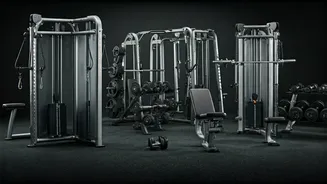Dumbbells: A Key
Dumbbells are a versatile tool for enhancing your physical condition and achieving various fitness objectives. They provide resistance training that builds
strength and promotes muscle growth across various muscle groups. The convenience of dumbbells allows for exercises that can be performed anywhere. They cater to different fitness levels, from beginners to experienced athletes, with adjustable weights that allow for a progressive increase in intensity. They facilitate a wide array of exercises that target all major muscle groups, enabling a comprehensive full-body workout. Dumbbells help develop better balance and coordination as they require each side of the body to work independently. This balanced engagement is beneficial for overall physical health and performance. Incorporating dumbbells can also increase metabolism by building muscle mass, which is a major benefit for anyone striving to improve their fitness and reach their goals.
Selecting the Right Pair
Choosing the appropriate dumbbells is pivotal for effective training. Consider your fitness goals when selecting dumbbells. Determine the weight range that aligns with your current strength level. Assess different dumbbell types, like adjustable, fixed-weight, or neoprene-coated, based on your workout preferences and budget. Ensure the dumbbells have comfortable and secure grips to prevent slippage during exercises. The weight increments should be appropriate for your progressive overload plans, as you will need to gradually increase the weight. Start with a lighter weight to perfect your form before increasing the load. This ensures that you can safely perform exercises with good technique and protect yourself from injuries. Proper form is crucial for maximizing muscle engagement and minimizing the risk of strains. Selecting the right dumbbells involves a thoughtful evaluation of your needs, from your desired fitness outcomes to the type of exercises you will include in your workouts.
Smart Training Tactics
Implementing smart strategies amplifies the effectiveness of your dumbbell workouts. Construct a balanced workout routine that includes compound movements such as squats and deadlifts, along with isolation exercises like bicep curls, ensuring that all muscle groups are thoroughly worked. Vary your exercises to prevent plateaus and keep your body challenged. Adjust the number of sets and repetitions to match your fitness goals. Embrace the principle of progressive overload by slowly increasing the weight, reps, or sets. Incorporate rest periods between sets. This rest allows your muscles to recover, preventing overtraining. Prioritize correct form and technique to reduce injury risk and optimize muscle activation. Listen to your body and adapt your workout schedule as required. Combine your dumbbell workouts with other types of exercises like cardio. Monitor your progress and make changes. This will help you stay motivated and focused on your fitness goals.














